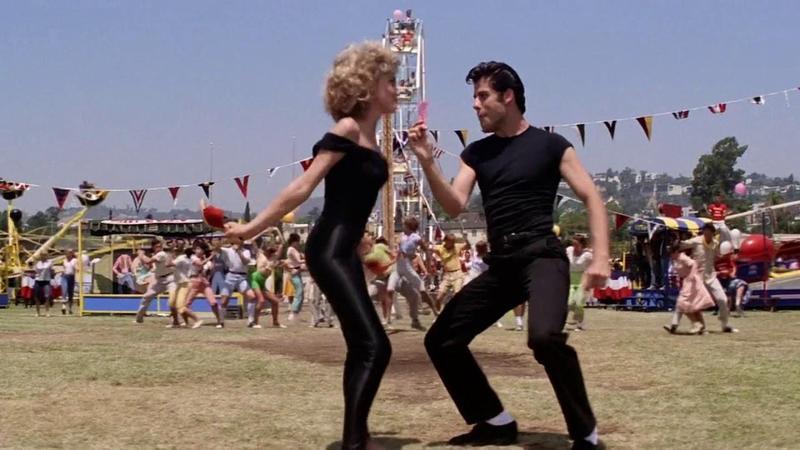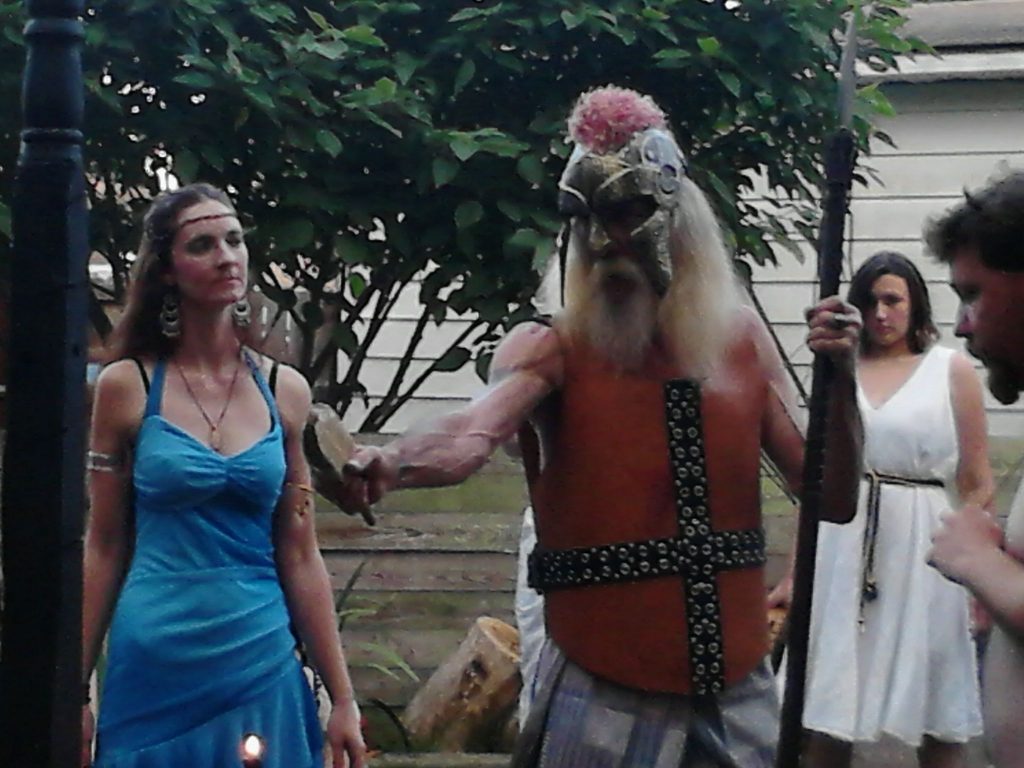
Terry Riley, high priest of the Southern Delta Church of Wicca (a part of the Aquarian Tabernacle Church), is preparing a Grease ritual for an upcoming new moon.
It’ll be a”special circle” that will have”a double high priest and a double high priestess so we can get both movies in,” Riley says with a chuckle. “We’re planning on using’ “Greased Lightnin” to raise the cone of power”
Movies? “Greased Lightnin’,” that John Travolta tune? Grease the film musical and not Greece the birthplace of Aphrodite, Persephone, Hekate and those classical goddesses and gods?
Indeed.

“We’ll be using all the characters from Grease and Grease 2, and we’re using the music from both of those to set up the circle,” Riley says by telephone from Lake City, Arkansas, where he and his late wife, Amanda, based their Wiccan church 25 years back. “We’re getting a good response. Everybody wants to come out and see this.”
Employing pop and rock songs – the genuine original records of renowned hits rather than rock-oriented works by Pagan musicians – is commonplace for Riley and also for Jason Mankey, a Wiccan Witch who, together with his spouse Ari, conducts an eclectic Wiccan coven and a Gardnerian coven in Silicon Valley, California.
Music by the Doors and AC/DC, plus the Beatles’“All You Need Is Love,” Fairport Convention’s”Come All Ye,” the Righteous Brothers’“Unchained Melody,” XTC’s”Green Man” as well as Nazareth’s”Hair of the Dog” (“Now you’re messin’ with a son of a bitch”) have been utilized by Mankey and Riley. Samhain rituals at the Florida Pagan Gathering have featured a recording of “Forever Autumn” by Justin Hayward of the Moody Blues, and a live performance by ritualists of Pink Floyd’s “Wish You Were Here.”
Such rock and pop classics are deployed just like any other music used in ritual: to set the mood and intentions, to evoke sacred space, to alter consciousness and to commune with the gods and goddesses.
Mankey experienced rock’n’roll in ritual for the first time 20 years back at Pagan Spirit Gathering when it had been held at the Wisteria community in Ohio.
“There was a guy there doing what he called the Jim Morrison ritual,” Mankey claims by phone from his California home. “It wasn’t really choreographed to the music. He just kind of played the Doors in the background, but I really loved the idea and it stuck with me and I borrowed it from him. Being initiated into the Morrison clan, which is what he offered that night, I decided it would be much cooler if you synced everything that went on in the ritual to the music.”
For his Doors-oriented ritual, Mankey used”Break on Through (to the Other Side)” to cast the circle and call the quarters. He utilized”Hello, I Love You” to call the goddess. To call Dionysius, he deployed “Alabama Song (Whiskey Bar),” a 1920s Bertolt Brecht/Kurt Weill work rejuvenated by Mr. Mojo Risin’ and company. Key lyric of the latter:“Show me the way to the next whiskey bar”
“Everybody really loved that ritual,” says Mankey, who writes the Raise the Horns blog on the Patheos Pagan channel. “It is a ritual about excess, and the Doors really fit the mood of that – they have this sort of spacey and trippy sound. That was when I was like,‘Whoa, rock’n’ roll can be really effective in ritual’ because it does create this mood and this soundscape and this feel that you don’t see in other places.”
Three years ago, Riley was “trying to figure out a way to bring in more young people to introduce them to the religion if they had an interested in it.
“I wanted a way to try to relate to them beyond the traditional chants and the traditional stuff of Wicca.”
He had the thought that the Southern Delta Church of Wicca must do “a Rocky Horror full moon circle complete with costumes, characters, and the music,” he states. “I got to play Riff Raff because I was the oldest guy there.
“We had over a hundred people, and we did the cone of power to the’Time Warp.’ We had everybody there up doing the dance and sending out the power. Everybody had a great time. Everybody told me was a brilliant idea.”
More rock in ritual followed at the church’s circles, which are always open to the public.
“The songs that were used back in the’60s and’70s have a higher meaning if you interpret them in a different way,” Riley says. “Like’In the Air Tonight’ from Phil Collins: should you hear this song and put it to use in circle, it is fantastic for a dark moon. It is possible to interpret it as the lord of the otherworld talking to the soul of man before he takes him on a spiral journey.
“I always tell people that if you listen to songs – especially the classic rock songs – as symbolism of a higher need, it’s usually the soul of man talking to the gods or it’s the gods talking to the soul of man, or it can be the gods talking to one another.”
When members of the Southern Delta Church of Wicca wanted to symbolically depict the great rite in circle, Riley and high priestess Ivy Moon danced to the Righteous Brothers’ 1965 version of”Unchained Melody,” which was revived in the 1990 film Ghost featuring Patrick Swayze and Demi Moore.
In a summer solstice ritual, Riley’s oak king was represented by Nazareth’s “Hair of the Dog” as he prepared to battle the holly king, played by his son to the sound of AC/DC’s “TNT.”
A ritual invoking Aphrodite and Ares featured the latter singing”Bang a Gong” by T. Rex, with Aphrodite replying via Pat Benatar’s “Hit Me with Your Best Shot.”
The Wiccan church’s”Roman version” of that same myth featured Venus singing”Venus” by Shocking Blue, while Mars sang”On the Dark Side” by John Cafferty and the Beaver Brown Band.
Pagans aren’t the only ones to regard rock music in magical and mythological terms.
In Ray Manzarek’s 1998 autobiography, Light My Fire: My Life with the Doors, the band’s keyboardist recounts the Doors’ infamous 1969 Miami concert, in which singer Jim Morrison was alleged to have exposed himself.
Manzarek describes that night in stark mythical imagery:“It was now time for the blood sacrifice of Dionysus and his musicians…. The maenads caught the flying Dionysus and gently lowered him to the ground, whereupon he began to dance with them in a swirling vortex that shape-shifted into a snakelike conga line as Jim worked his way through the crowd, his followers behind him… . that damned satyr was there, too, cackling and hopping on his goat hooves. What a night for that little beast. Exactly the kind of action he had come back for.”
In the mid-1970s, beat writer Williams Burroughs was asked to write about a Led Zeppelin concert for Crawdaddy magazine:“The essential ingredient for any successful rock group is energy – the ability to give out energy, to receive energy from the audience and to give it back to the audience. A rock concert is in fact a rite involving the evocation and transmutation of energy. Rock stars may be compared to priests … It is to be remembered that the origin of all the arts – music, painting, and writing – is magical and evocative, and that magic is always used to obtain some definite result. In the Led Zeppelin concert, the result aimed at would seem to be the creation of energy in the performers and in the audience.”
Riley sees no conflict between melding traditional Wicca with modern rock in circle:“It’s an evolving and growing religion just like every other faith in the world out there.”
“I love rock’n’ roll – not just the classic bands but things that are more contemporary too,” states Mankey, who notes Led Zeppelin is his favourite group. “I love to insert rock into ritual whenever I can. I won’t do it if it doesn’t feel appropriate. There are times when it works and there are times that it doesn’t work.”
Be the first to post a message!